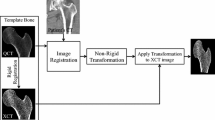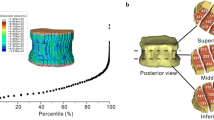Abstract
Patient-specific biomechanical models including local bone mineral density and anisotropy have gained importance for assessing musculoskeletal disorders. However the trabecular bone anisotropy captured by high-resolution imaging is only available at the peripheral skeleton in clinical practice. In this work, we propose a supervised learning approach to predict trabecular bone anisotropy that builds on a novel set of pose invariant feature descriptors. The statistical relationship between trabecular bone anisotropy and feature descriptors were learned from a database of pairs of high resolution QCT and clinical QCT reconstructions. On a set of leave-one-out experiments, we compared the accuracy of the proposed approach to previous ones, and report a mean prediction error of 6% for the tensor norm, 6% for the degree of anisotropy and 19° for the principal tensor direction. These findings show the potential of the proposed approach to predict trabecular bone anisotropy from clinically available QCT images.
Chapter PDF
Similar content being viewed by others
References
Kopperdahl, D.L., Aspelund, T., Hoffmann, P.F., Sigurdsson, S., Siggeirsdottir, K., Harris, T.B., Gudnason, V., Keaveny, T.M.: Assessment of incident spine and hip fractures in women and men using finite element analysis of CT scans. Journal of Bone and Mineral Research 29(3) (2014)
Maquer, G., Musy, S.N., Wandel, J., Gross, T., Zysset, P.K.: Bone Volume Fraction and Fabric Anisotropy Are Better Determinants of Trabecular Bone Stiffness than Other Morphological Variables. Journal of Bone and Mineral Research (2014)
Enns-Bray, W.S., Owoc, J.S., Nishiyama, K.K., Boyd, S.K.: Mapping anisotropy of the proximal femur for enhanced image based finite element analysis. Journal of Biomechanics 47(13) (2014)
Hazrati Marangalou, J., Ito, K., Cataldi, M., Taddei, F., van Rietbergen, B.: A novel approach to estimate trabecular bone anisotropy using a database approach. Journal of Biomechanics 46(14) (2013)
Taghizadeh, E., Maquer, G., Reyes, M., Büchler, P.: Including the trabecular anisotropy from registered microCT data in homogenized FE model improves the bones mechanical predictions. In: CMBBE (2014)
Lekadir, K., Hazrati-Marangalou, J., Hoogendoorn, C., Taylor, Z., van Rietbergen, B., Frangi, A.F.: Statistical estimation of femur micro-architecture using optimal shape and density predictors. Journal of Biomechanics 48(4) (2015)
Kang, Y., Engelke, K., Fuchs, C., Kalender, W.A.: An anatomic coordinate system of the femoral neck for highly reproducible BMD measurements using 3D QCT. Computerized Medical Imaging and Graphics 29(7) (2005)
Kang, Y., Engelke, K., Kalender, W.A.: A New Accurate and Precise 3-D Segmentation Method for Skeletal Structures in Volumetric CT Data. IEEE TMI 22(5) (2003)
Haralick, R.M., Shanmugam, K.: Textural Features for Image Classification. IEEE TSMC 3(6) (1973)
Ortiz, A., Palacio, A.A., Górriz, J.M., Ramírez, J., Salas-González, D.: Segmentation of brain MRI using SOM-FCM-based method and 3D statistical descriptors. Computational and Mathematical Methods in Medicine (2013)
Harrigan, T., Mann, R.: Characterization of microstructural anisotropy in orthotropic materials using a second rank tensor. Journal of Materials Science 19(3) (1984)
Pennec, X., Fillard, P., Ayache, N.: A Riemannian Framework for Tensor Computing. International Journal of Computer Vision 66(1) (2006)
Dumont, M., Marée, R.: Fast multi-class image annotation with random windows and multiple output randomized trees. In: Proc. of VISAPP, vol. 2 (2009)
Marée, R., Wehenkel, L., Geurts, P.: Extremely randomized trees and random subwindows for image classification, annotation, and retrieval. In: Decision Forests for Computer Vision and Medical Image Analysis (2013)
Dall’Ara, E., Luisier, B., Schmidt, R., Kainberger, F., Zysset, P., Pahr, D.: A nonlinear QCT-based finite element model validation study for the human femur tested in two configurations in vitro. Bone 52(1) (2013)
Pahr, D.H., Zysset, P.K.: From high-resolution CT data to finite element models: development of an integrated modular framework. CMBBE Journal 12(1) (2009)
Klein, S., Staring, M., Murphy, K., Viergever, M.A., Pluim, J.P.W.: elastix: A toolbox for intensity-based medical image registration. IEEE Trans. Med. Imaging 29(1) (2010)
Author information
Authors and Affiliations
Corresponding author
Editor information
Editors and Affiliations
Rights and permissions
Copyright information
© 2015 Springer International Publishing Switzerland
About this paper
Cite this paper
Chandran, V., Zysset, P., Reyes, M. (2015). Prediction of Trabecular Bone Anisotropy from Quantitative Computed Tomography Using Supervised Learning and a Novel Morphometric Feature Descriptor. In: Navab, N., Hornegger, J., Wells, W., Frangi, A. (eds) Medical Image Computing and Computer-Assisted Intervention -- MICCAI 2015. MICCAI 2015. Lecture Notes in Computer Science(), vol 9349. Springer, Cham. https://doi.org/10.1007/978-3-319-24553-9_76
Download citation
DOI: https://doi.org/10.1007/978-3-319-24553-9_76
Published:
Publisher Name: Springer, Cham
Print ISBN: 978-3-319-24552-2
Online ISBN: 978-3-319-24553-9
eBook Packages: Computer ScienceComputer Science (R0)




